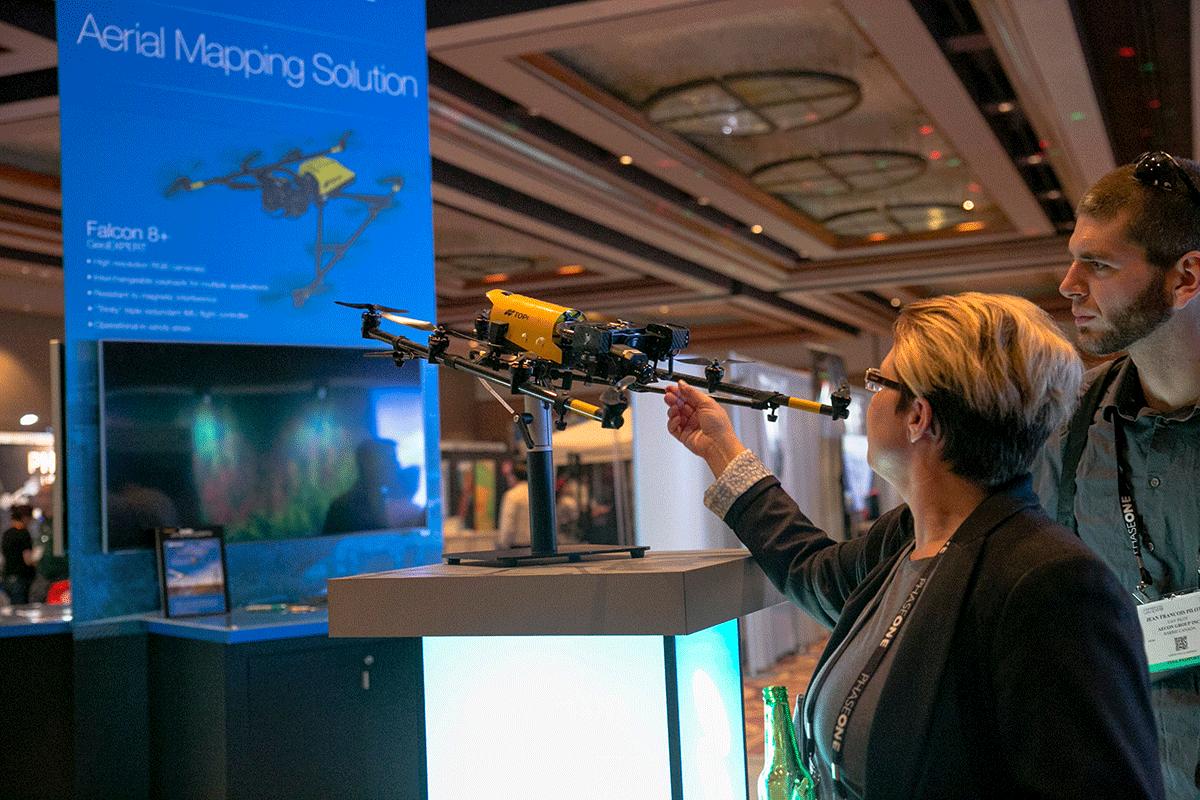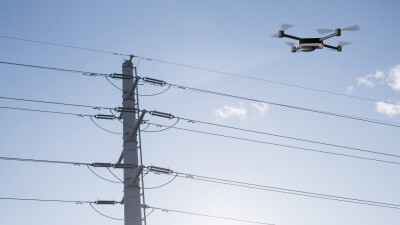 Dr. Mohamed M.R. Mostafa, CTO at Navmatica Corp., presented a detailed, and very scientific analysis of the comparison of GPS vs GNSS receivers and the difference in terms of accuracy and flying time. According to his research, by using GNSS (a constellation of satellites that could include not only GPS but the Russian Glonass, the European Galileo and the Chinese Beidu constellations), he and his team were able to reduce the need for GCP and increased accuracy. Dr. Mostafa made a very compelling case for Direct Georeferencing as opposed to the traditional method of aerotriangulation.The last presentation of the session was a comprehensive comparison of UAV-based LIDAR vs. Photogrammetry by Curtis Park, GM at RME Geomatics. In this interesting study, Curtis and his team selected a land site and measured it from an AUV using both LIDAR and traditional photogrammetry. The results are incredible and their findings are an eye opener in terms of costs, accuracy, flying time, processing time and equipment price.According to Curtis both techniques have pros and cons but he recommends LIDAR for jobs that are not texture and contrast dependent; LIDAR requires more people time and less CPU time than photogrammetry but the LIDAR sensor is considerably more expensive than the photogrammetric camera. The main conclusion was that there is no single sensor, aircraft or software package that does it all.At the end of the four presentations Baptiste Tripard of Intel, Adam Boczek of Sumac, Will Tompkinson of Insightful Dimensions and Lewis Graham of GeoCue Group joined the presenters in a 15 minute panel discussion with the audience.
Dr. Mohamed M.R. Mostafa, CTO at Navmatica Corp., presented a detailed, and very scientific analysis of the comparison of GPS vs GNSS receivers and the difference in terms of accuracy and flying time. According to his research, by using GNSS (a constellation of satellites that could include not only GPS but the Russian Glonass, the European Galileo and the Chinese Beidu constellations), he and his team were able to reduce the need for GCP and increased accuracy. Dr. Mostafa made a very compelling case for Direct Georeferencing as opposed to the traditional method of aerotriangulation.The last presentation of the session was a comprehensive comparison of UAV-based LIDAR vs. Photogrammetry by Curtis Park, GM at RME Geomatics. In this interesting study, Curtis and his team selected a land site and measured it from an AUV using both LIDAR and traditional photogrammetry. The results are incredible and their findings are an eye opener in terms of costs, accuracy, flying time, processing time and equipment price.According to Curtis both techniques have pros and cons but he recommends LIDAR for jobs that are not texture and contrast dependent; LIDAR requires more people time and less CPU time than photogrammetry but the LIDAR sensor is considerably more expensive than the photogrammetric camera. The main conclusion was that there is no single sensor, aircraft or software package that does it all.At the end of the four presentations Baptiste Tripard of Intel, Adam Boczek of Sumac, Will Tompkinson of Insightful Dimensions and Lewis Graham of GeoCue Group joined the presenters in a 15 minute panel discussion with the audience.Subscribe
The information you submit will be stored and used to communicate with you about your interest in Commercial UAV News. To understand more about how we use and store information, please refer to our privacy policy.
November 16, 2016
Experiencing the Surveying and Mapping Track at the Commercial UAV Expo

At the Surveying and Mapping Track which took place during the 2016 Commercial UAV Expo in Las Vegas, attendees were exposed to a number of show cases and new measuring techniques that are worth mentioning.In an in-depth analysis of a challenging UAV mapping job of the Rock of Gibraltar, Mr. Adrian Charter described in great technical detail, the tribulations and workarounds he and his team at Land & Minerals Consulting Ltd., went through to complete the task. This was no ordinary mapping engagement, the escarpments had slopes of 35% and up, the location of the job was close to an international airport and the UK restrictions for UAV flying altitude and distance from operator made for a very challenging endeavor.Adrian and his team were eventually successful. The lessons they learned when using UAVs for mapping in difficult terrain and near obstacles were to be flexible and to keep safety as the dominant goal.Following this experience in Gibraltar, Rob Hranac, VP of Business Development at Swift Navigation, gave the audience a very detailed analysis of the advantages of using Real Time Kinematic (RTK) during UAV mapping jobs, illustrating his point with examples and test flights. One of the most striking conclusions of Rob’s presentation was the fact that using RTK dramatically reduces flying time, photographic overlap and the need for Ground Control Points (GCP). Dr. Mohamed M.R. Mostafa, CTO at Navmatica Corp., presented a detailed, and very scientific analysis of the comparison of GPS vs GNSS receivers and the difference in terms of accuracy and flying time. According to his research, by using GNSS (a constellation of satellites that could include not only GPS but the Russian Glonass, the European Galileo and the Chinese Beidu constellations), he and his team were able to reduce the need for GCP and increased accuracy. Dr. Mostafa made a very compelling case for Direct Georeferencing as opposed to the traditional method of aerotriangulation.The last presentation of the session was a comprehensive comparison of UAV-based LIDAR vs. Photogrammetry by Curtis Park, GM at RME Geomatics. In this interesting study, Curtis and his team selected a land site and measured it from an AUV using both LIDAR and traditional photogrammetry. The results are incredible and their findings are an eye opener in terms of costs, accuracy, flying time, processing time and equipment price.According to Curtis both techniques have pros and cons but he recommends LIDAR for jobs that are not texture and contrast dependent; LIDAR requires more people time and less CPU time than photogrammetry but the LIDAR sensor is considerably more expensive than the photogrammetric camera. The main conclusion was that there is no single sensor, aircraft or software package that does it all.At the end of the four presentations Baptiste Tripard of Intel, Adam Boczek of Sumac, Will Tompkinson of Insightful Dimensions and Lewis Graham of GeoCue Group joined the presenters in a 15 minute panel discussion with the audience.
Dr. Mohamed M.R. Mostafa, CTO at Navmatica Corp., presented a detailed, and very scientific analysis of the comparison of GPS vs GNSS receivers and the difference in terms of accuracy and flying time. According to his research, by using GNSS (a constellation of satellites that could include not only GPS but the Russian Glonass, the European Galileo and the Chinese Beidu constellations), he and his team were able to reduce the need for GCP and increased accuracy. Dr. Mostafa made a very compelling case for Direct Georeferencing as opposed to the traditional method of aerotriangulation.The last presentation of the session was a comprehensive comparison of UAV-based LIDAR vs. Photogrammetry by Curtis Park, GM at RME Geomatics. In this interesting study, Curtis and his team selected a land site and measured it from an AUV using both LIDAR and traditional photogrammetry. The results are incredible and their findings are an eye opener in terms of costs, accuracy, flying time, processing time and equipment price.According to Curtis both techniques have pros and cons but he recommends LIDAR for jobs that are not texture and contrast dependent; LIDAR requires more people time and less CPU time than photogrammetry but the LIDAR sensor is considerably more expensive than the photogrammetric camera. The main conclusion was that there is no single sensor, aircraft or software package that does it all.At the end of the four presentations Baptiste Tripard of Intel, Adam Boczek of Sumac, Will Tompkinson of Insightful Dimensions and Lewis Graham of GeoCue Group joined the presenters in a 15 minute panel discussion with the audience.
 Dr. Mohamed M.R. Mostafa, CTO at Navmatica Corp., presented a detailed, and very scientific analysis of the comparison of GPS vs GNSS receivers and the difference in terms of accuracy and flying time. According to his research, by using GNSS (a constellation of satellites that could include not only GPS but the Russian Glonass, the European Galileo and the Chinese Beidu constellations), he and his team were able to reduce the need for GCP and increased accuracy. Dr. Mostafa made a very compelling case for Direct Georeferencing as opposed to the traditional method of aerotriangulation.The last presentation of the session was a comprehensive comparison of UAV-based LIDAR vs. Photogrammetry by Curtis Park, GM at RME Geomatics. In this interesting study, Curtis and his team selected a land site and measured it from an AUV using both LIDAR and traditional photogrammetry. The results are incredible and their findings are an eye opener in terms of costs, accuracy, flying time, processing time and equipment price.According to Curtis both techniques have pros and cons but he recommends LIDAR for jobs that are not texture and contrast dependent; LIDAR requires more people time and less CPU time than photogrammetry but the LIDAR sensor is considerably more expensive than the photogrammetric camera. The main conclusion was that there is no single sensor, aircraft or software package that does it all.At the end of the four presentations Baptiste Tripard of Intel, Adam Boczek of Sumac, Will Tompkinson of Insightful Dimensions and Lewis Graham of GeoCue Group joined the presenters in a 15 minute panel discussion with the audience.
Dr. Mohamed M.R. Mostafa, CTO at Navmatica Corp., presented a detailed, and very scientific analysis of the comparison of GPS vs GNSS receivers and the difference in terms of accuracy and flying time. According to his research, by using GNSS (a constellation of satellites that could include not only GPS but the Russian Glonass, the European Galileo and the Chinese Beidu constellations), he and his team were able to reduce the need for GCP and increased accuracy. Dr. Mostafa made a very compelling case for Direct Georeferencing as opposed to the traditional method of aerotriangulation.The last presentation of the session was a comprehensive comparison of UAV-based LIDAR vs. Photogrammetry by Curtis Park, GM at RME Geomatics. In this interesting study, Curtis and his team selected a land site and measured it from an AUV using both LIDAR and traditional photogrammetry. The results are incredible and their findings are an eye opener in terms of costs, accuracy, flying time, processing time and equipment price.According to Curtis both techniques have pros and cons but he recommends LIDAR for jobs that are not texture and contrast dependent; LIDAR requires more people time and less CPU time than photogrammetry but the LIDAR sensor is considerably more expensive than the photogrammetric camera. The main conclusion was that there is no single sensor, aircraft or software package that does it all.At the end of the four presentations Baptiste Tripard of Intel, Adam Boczek of Sumac, Will Tompkinson of Insightful Dimensions and Lewis Graham of GeoCue Group joined the presenters in a 15 minute panel discussion with the audience.














Comments